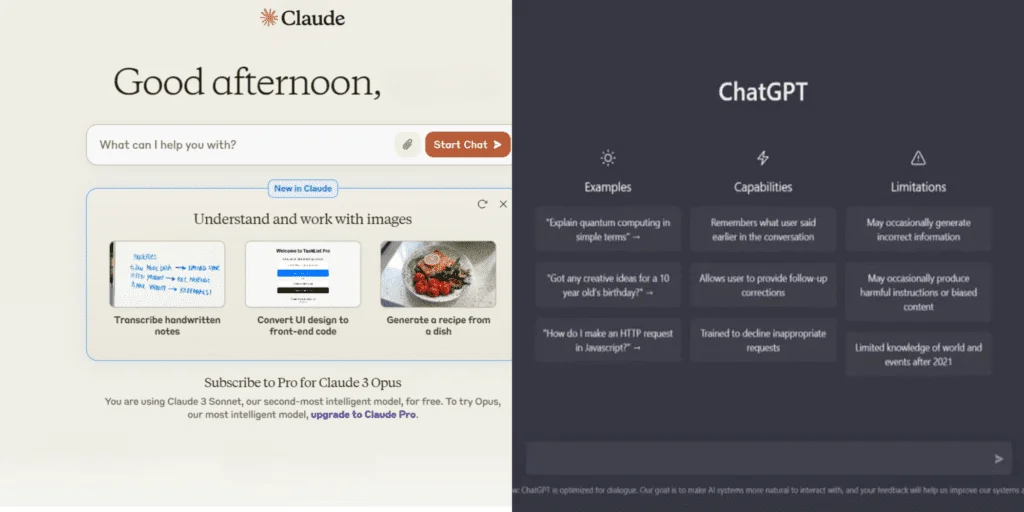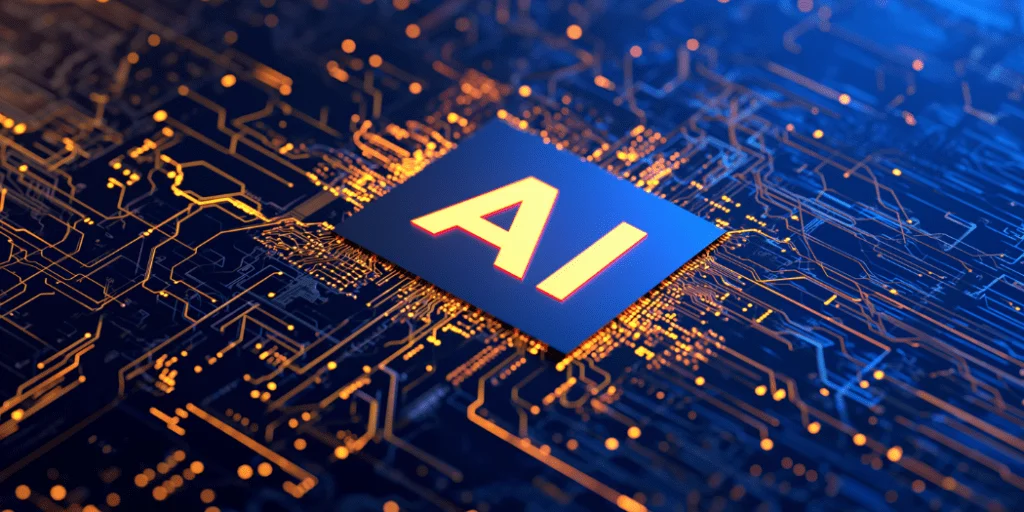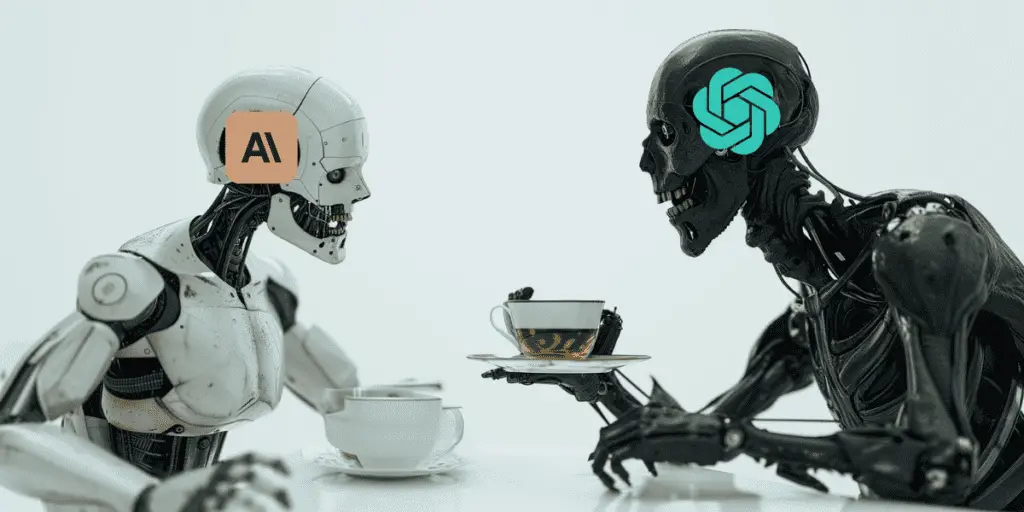Two titans have emerged at the forefront of the generative AI arena: Anthropic’s Claude AI and OpenAI’s ChatGPT. These models stand as pinnacles of current AI capabilities, each offering unique strengths, features, and philosophies that reflect their creators’ visions.
As AI continues intertwining with daily tasks, business operations, and creative processes, the choice between Claude AI and ChatGPT becomes both technical and strategic.
Developed by Anthropic and OpenAI, Claude AI and ChatGPT, respectively, are built on some of the most sophisticated large language models available today.
Their introduction has sparked widespread interest, drawing users from across the spectrum—from casual enthusiasts to tech giants seeking to integrate AI into their services.
Both models have been crafted with a keen eye on performance, usability, and safety. Yet, they navigate these priorities in distinct ways that mirror the ethos and objectives of their parent companies.
This burgeoning interest in generative AI tools brings many questions regarding the best fit for various projects and use cases.
This article delves into these questions, thoroughly comparing Claude AI and ChatGPT.
By examining their model options, cost structures, technical prowess, privacy policies, and unique features, we aim to provide a comprehensive guide that illuminates the path for individuals and organizations navigating the choice between these AI powerhouses.
Whether you’re looking to automate complex workflows, spark creativity, or simply explore the boundaries of what AI can achieve, understanding the nuances between Claude AI and ChatGPT is a crucial step in harnessing the transformative power of generative AI.
Model Options and Accessibility
When considering the adoption of a generative AI tool for your project, it is crucial to understand the range of models available and how they can be accessed.
Anthropic’s Claude AI and OpenAI’s ChatGPT offer multiple versions of their underlying large language models, each designed to cater to different needs and preferences.
Anthropic has introduced the Claude 3 model family, a significant advancement from its predecessor, Claude 2. This latest iteration comes in three versions, each aimed at a distinct segment of users:
As the flagship model, Opus represents Anthropic’s most sophisticated offering. It is tailored for complex tasks such as strategic planning, in-depth research, and advanced workflow automation.
Available through both the Claude AI web app for a monthly subscription fee and Anthropic’s API for developers, Opus combines high performance with a premium cost.
Positioned as a mid-tier option, Sonnet balances affordability and capability. It supports many tasks, including data processing and code generation, making it versatile for both individual and enterprise users.
Sonnet can be accessed for free via the Claude AI web app, with API usage subject to usage-based fees. Haiku is the most economical model in the Claude 3 series, designed for efficiency and rapid response.
It excels at customer support, content moderation, and tasks requiring quick, concise answers. Haiku’s affordability and performance make it an attractive option for businesses focused on cost-efficiency.
Each model boasts a 200,000-token context window and can handle up to 1 million tokens for specific applications. It offers users a broad canvas for their interactions. However, unlike ChatGPT, Claude’s AI models currently do not support image generation, voice interaction, or web browsing.
OpenAI provides a broader array of model options, including GPT-4, the engine behind the latest version of ChatGPT, and GPT-3.5, which powers the initial release. These models offer varying capabilities and access levels:
This model is the pinnacle of OpenAI’s current offerings. It supports advanced features like image generation, voice interaction, and a context window of up to 128,000 tokens.
GPT-4 can be accessed through OpenAI’s subscription plans, catering to a broad spectrum of user needs from casual exploration to enterprise-level deployment.
Aiming to provide a more accessible entry point, GPT-3.5 powers the free version of ChatGPT. While it lacks some advanced features of GPT-4, such as internet browsing, it remains a powerful tool for a wide range of text-based tasks.
OpenAI also offers specialized models like Dall-E for image creation and Whisper for speech-to-text, further expanding the utility and versatility of its AI suite.

Cost Analysis
In the dynamic world of generative AI, the cost of accessing and utilizing large language models like Claude AI and ChatGPT is a crucial consideration for individual developers and organizations.
Anthropic and OpenAI have structured their pricing models to cater to a range of users, from casual enthusiasts to large-scale enterprise operations.
Claude AI Pricing
Anthropic’s pricing strategy for the Claude 3 model family accommodates a broad spectrum of use cases, from basic customer support tasks to complex research and strategy development. The cost structure varies across the three versions of Claude 3:
As Anthropic’s premium offering, Opus is available for a $20 monthly subscription via the Claude AI web app. Developers can access it through Anthropic’s API at $15 per million input tokens and $75 per million output tokens, reflecting its advanced capabilities for intricate tasks.
Sonnet is the middle-tier model, free to use within the Claude AI web app, making it an attractive option for users seeking a balance between cost and functionality. API access costs $3 per million input tokens and $15 per million output tokens, a rate designed to appeal to developers and businesses with moderate AI needs.
The most economical option, Haiku, is tailored for tasks requiring quick and efficient responses. It costs $0.25 per million input tokens and $1.25 per million output tokens via Anthropic’s API, presenting a cost-effective solution for businesses focused on customer support and content moderation.
ChatGPT Pricing
OpenAI has structured its ChatGPT offerings to provide flexibility and scalability with a pricing model that spans free access to more advanced, paid subscriptions and API usage rates:
The foundational model behind ChatGPT’s initial release is accessible for free through the ChatGPT web app, catering to users with basic AI requirements. This version offers robust capabilities without the advanced features of its successor, GPT-4.
OpenAI’s flagship model, GPT-4, is available to users via a $20 monthly ChatGPT Plus subscription, offering enhanced features, such as image generation and web browsing. OpenAI’s API pricing for GPT-4 and other models varies, depending on the use case and volume, with detailed rates available on OpenAI’s website.
OpenAI’s API supports a range of models, including GPT -4 and GPT-3.5, and specialized models like Dall-E and Whisper. It offers flexible pricing that adjusts based on the model used and the volume of tokens processed. This allows developers and businesses to scale their usage according to their needs.
Technical Specifications
In the competitive landscape of generative AI, the technical specifications and performance of large language models like Claude AI and ChatGPT play a pivotal role in determining their suitability for various applications.
While both Anthropic and OpenAI have been reticent about divulging their models’ intricate details, enough information is available to offer insights into their architectures, capabilities, and performance benchmarks.
Model Size and Architecture: Anthropic has not publicly disclosed the exact size of the Claude 3 models. However, it is known that Claude utilizes a transformer-based architecture, a standard in modern LLMs, optimized for efficiency and performance.
Reports suggest that Claude 3 models are estimated to have at least 175 billion parameters, indicating a substantial capacity for understanding and generating complex language patterns.
Performance and Applications: Claude 3’s performance is tailored across its three versions to cater to various applications, from complex strategy formulation and research to efficient customer support.
Anthropic highlights Claude 3’s ability to process and generate responses within a 200,000-token context window, supporting tasks that require large-scale data comprehension and interaction.
A hallmark of Claude AI is its emphasis on reducing AI risk, a reflection of Anthropic’s broader safety-centric philosophy. This includes mechanisms to ensure responses are aligned with ethical guidelines and user expectations, aiming to mitigate the potential for generating harmful or misleading content.
OpenAI’s GPT-4, the technology behind the latest iteration of ChatGPT, represents a significant leap in LLM capabilities, with an architecture that supports over 1 trillion parameters.
This immense size enables GPT-4 to understand and generate text with a nuanced understanding of human language, context, and subtleties.
GPT-4’s advanced capabilities include image generation, voice interaction, and web browsing, setting a new standard for multimodal AI interactions.
Its performance is showcased through a context window of up to 128,000 tokens, allowing for deep and coherent long-form conversation and content creation.
ChatGPT users can leverage GPT-4 to create custom assistants tailored to specific tasks, enhancing the model’s versatility and application across various industries and use cases.
Claude AI and ChatGPT have been subjected to various benchmarks and evaluations designed to test their linguistic capabilities, comprehension, and generation quality.
Anthropic claims Claude 3 has outperformed GPT-4 in specific benchmarks, particularly emphasizing its safety and risk reduction features.
Direct comparisons should be cautiously approached due to variations in benchmark methodologies and the absence of standardized evaluation metrics across the industry.
Independent assessments and user-generated rankings provide additional layers of comparison. Platforms like Chatbot Arena offer crowdsourced evaluations, with Claude’s Opus model and GPT-4 receiving high performance and user satisfaction marks.

Privacy and Security Features
Generative AI, where large language models like Claude AI and ChatGPT process vast amounts of data, including potentially sensitive information, privacy, and security features, are of paramount importance.
Users, ranging from individuals to large enterprises, must trust that their interactions with these AI models are secure and that their data is handled carefully. Here’s how Anthropic’s Claude and OpenAI’s ChatGPT approach these critical concerns.
AI Safety and Ethical Use: Anthropic, the creator of Claude AI, has placed a strong emphasis on minimizing AI risks and enhancing model safety.
This approach is evident in the development of Claude, which is designed with a safety-centric ethos and incorporates mechanisms to prevent the generation of harmful or inappropriate content.
Unlike some AI models that use user interactions for continuous training by default, Anthropic does not automatically retrain Claude on user inputs. Instead, it adopts an opt-in approach, where users can use their data for model improvement.
This policy offers an additional layer of privacy: User interactions are not used to inform the model unless explicitly permitted.
Claude’s responses are engineered to be more reserved, especially when handling sensitive topics. This reflects Anthropic’s commitment to privacy and ethical considerations. This careful approach balances the model’s utility with protecting user data and maintaining trust.
OpenAI’s ChatGPT, in contrast, employs user interactions for model retraining as a default setting. This approach helps refine the model’s responses and improve performance over time.
Users concerned about privacy can opt out of this data usage by not saving chat history or submitting a privacy request to stop OpenAI from using their data for model training.
ChatGPT includes safety protocols to mitigate the risk of generating dangerous or offensive content. These measures are part of OpenAI’s broader effort to ensure that ChatGPT operates within ethical boundaries and respects user sensitivities.
Although these protocols are less stringent than Claude’s, they balance openness and creativity with safety and respect for user preferences.
OpenAI acknowledges the importance of data security and implements robust measures to protect user information. However, the exact details of these practices are not always fully disclosed, which is common in AI development’s competitive and proprietary nature.
Both Claude AI and ChatGPT are designed with an awareness of the critical importance of privacy and security in the AI space.
Anthropic Claude takes a more conservative approach, prioritizing safety and opting for user consent in data retraining.
OpenAI’s ChatGPT, while also providing mechanisms for user control over data, leans towards leveraging user interactions for continuous improvement, with safeguards in place to prevent misuse.
The choice between Claude AI and ChatGPT from a privacy and security perspective will depend on the user’s specific needs and preferences.
Those who prioritize maximum control over their data might prefer Claude’s opt-in model and cautious approach to content generation. In contrast, users who value the benefits of continuous model improvement and are comfortable with OpenAI’s opt-out data usage policy might prefer ChatGPT.
Claude AI Vs ChatGPT
| Feature | Claude AI | ChatGPT |
| Model Options | Claude 3 Opus, Sonnet, Haiku | GPT-4, GPT-3.5, specialized models like Dall-E and Whisper |
| Cost | – Opus: $20/month for web app, $15 per million input tokens, $75 per million output tokens for API | – GPT-4: Available through $20/month ChatGPT Plus subscription |
| – Sonnet: Free in web app, $3 per million input tokens, $15 per million output tokens for API | – GPT-3.5: Free access through ChatGPT web app | |
| – Haiku: $0.25 per million input tokens, $1.25 per million output tokens for API | – API pricing varies by model and usage | |
| Technical Specifications | – Transformer-based architecture, size undisclosed but significant | – GPT-4 has over 1 trillion parameters, transformer-based architecture |
| – Emphasis on reducing AI risk with a focus on safety | – Supports advanced features like image generation, voice interaction, web browsing | |
| Performance | – Tailored performance across models for different applications | – High performance with multimodal interactions and customization options |
| – Claims to surpass GPT-4 in certain benchmarks | – Benchmark performance highly regarded, though direct comparisons are nuanced | |
| Privacy & Security | – Does not use user data for retraining by default; opt-in approach | – Retrains on user interactions by default, with an option to opt out |
| – More reserved in responses, prioritizing safety | – Safety measures in place, though less stringent than Claude |

Final Thoughts
Claude AI by Anthropic and ChatGPT by OpenAI stand out as leading contenders. Each has unique strengths, cost structures, and technological advancements.
This comparative analysis illuminates the key differences and similarities between the two, offering potential users a detailed overview to guide their choice based on specific needs, preferences, and priorities.
Claude AI is distinguished by its focus on AI safety and ethical considerations. It offers a tiered model structure that caters to a range of applications, from simple customer support tasks to complex strategic planning.
Its straightforward cost model allows users to choose based on their budget and requirements. Anthropic’s emphasis on user privacy and the opt-in approach for data retraining speaks to its commitment to minimizing AI risks, making Claude an appealing option for users and organizations prioritizing data security and ethical AI use.
ChatGPT, however, showcases OpenAI’s prowess in creating a versatile and powerful tool that excels in multimodal interactions and customization.
The breadth of model options, including GPT-4’s advanced image generation, voice interaction, and web browsing capabilities, positions ChatGPT as a highly adaptable AI companion for various tasks.
While its approach to user data and privacy offers flexibility, it emphasizes the benefits of continuous improvement through user interactions, balanced with safety measures to mitigate misuse.
Ultimately, the choice between Claude AI and ChatGPT hinges on the specific requirements and values of the user. Those seeking an AI tool that emphasizes safety, privacy, and ethical AI may lean towards Claude AI.
In contrast, users looking for advanced multimodal capabilities, extensive customization, and the integration of cutting-edge AI features might find ChatGPT more aligned with their needs.
As AI continues to evolve, both Anthropic and OpenAI will likely introduce further innovations and improvements to their models, continually pushing the boundaries of what generative AI can achieve.
For users, staying informed about these developments will be vital to leveraging AI’s transformative power in their personal and professional endeavors.


